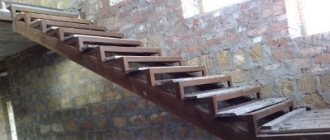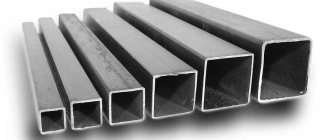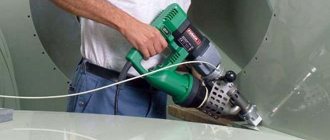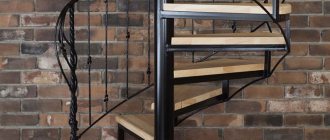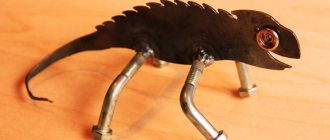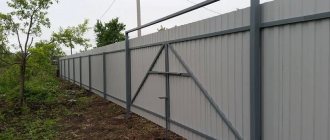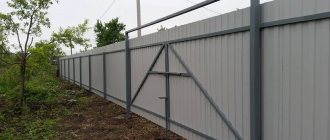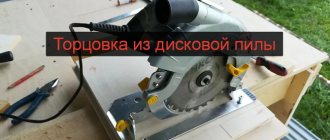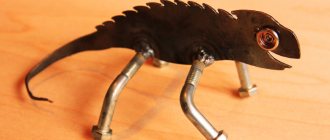Another welding option is from a corner. But to ensure the rigidity of the stairs, a large corner will be required, which means a significant waste of metal. You can use two small corners, but then they need to be welded to increase the profile of the bowstring.
No house is complete without a staircase. They are required to enter the house, to the second floor, attic or attic. Most people choose metal stairs. This is due to the advantages of the metal, its strength, durability, and the ability to give it any shape.
In addition to stationary ones, a mobile one is often required; for housework and gardening, an extension ladder or stepladder is always needed. Welding metal stairs is the best option.
Metal frame for interior stairs.
Do-it-yourself metal staircase: is it needed at all?
When talking about metal stairs, we can mean two types of structures: those made entirely of metal and stairs with metal frames. Both of them can be done on your own. What is the difference and how to choose the best option? How to weld a ladder and what is needed for this?
Stairs on metal frames are an excellent interior solution. They have a modern look, look very stylish, are quite durable and reliable, but are often more expensive compared to classic wooden ones. Only the frame of such stairs is made of metal - bowstrings or stringers. The handrail of the fence and steps are made of wood, and the vertical supports of the fence (balustrade) are optional; they can be either wooden or metal.
Metal frame for interior stairs.
But we will dwell in more detail on how to weld a ladder entirely from metal yourself. Such staircases can be used as interior ones, but it is very important to understand that metal is a “cold” material; unlike wood, it will rather bring a certain indifference and detachment into the house, helping little to create coziness. Keep this in mind if you are going to make a metal staircase to go up to the second floor in your living space.
Another thing is street stairs made of metal. They look truly impressive. But this is not the most important thing - no other type of stairs is simply suitable for outdoor use, since only steel can withstand unfavorable environmental conditions for many decades - rain, snow, low temperatures, etc. You can weld a metal staircase for the street at home conditions, and you will get a moderately expensive and fairly reliable design.
Street staircase made of metal.
Finally, another advantage of metal stairs is their highest strength, which cannot be compared even with high-quality wooden stairs.
So, let’s make a metal street staircase with our own hands!
Preparation of stringers begins with choosing a profile; the most common is a channel or an I-beam, but this is not the entire list of available configurations; the figure below shows various options.
General requirements
Stairs to the second floor, metal or wooden, are made with safety and ease of use in mind. The general requirements for structures are as follows:
- The width of the flight of stairs must be at least 90 centimeters. For the simultaneous passage of two people, the optimal values are from 120 to 150 cm.
- It is necessary to correctly calculate the angle of inclination of the march. The most optimal value is from 30 to 45 degrees. If you make the angle smaller, the entire structure will take up a lot of space; if it is larger, then moving up the stairs will be difficult and unsafe.
- For ease of movement, calculations are made of the height and depth of the steps. According to current practice, the first parameter should be within 15-20 cm. The depth of the steps is made according to the length of the foot - from 20 to 30 cm.
- Fences are not always used. But in the case of a family with children, you cannot do without them. According to general requirements, the distance between the staircase railing posts must be at least 12 cm.
- It is also necessary to make load calculations. The minimum weight that a steel structure must support is 100 kg. If there are larger members in the family, then the strength of the ladder should be appropriate.
Methods for manufacturing metal staircase structures
Types of metal stairs according to the manufacturing method are divided into three options:
- Forged
- Cast
- Welded
If you do not have blacksmithing skills, making forged metal stairs at home is a difficult task, the only option is to turn to professionals for help and order manufacturing and installation from them, or after making your calculations, order individual elements of the stairs from a blacksmith, and have the assembly and installation done yourself. Forged staircase structures are exclusive in production, since the forging process is still done by hand.
The material for manufacturing cast metal structures is cast iron; this manufacturing method is expensive and only practical on a production scale.
Welded metal stairs are much easier to manufacture compared to forged or cast ones; with the right desire, anyone can weld a staircase with their own hands at home, but this work also requires basic knowledge of welding.
(Click on image to enlarge)
By drawing a diagram of the design of the future staircase, a person makes his task easier in the process of installing the gangway.
Classification
Metal stairs are used permanently or temporarily. According to their purpose they are classified:
- to the main ones, serving for general use;
- auxiliary - service, spare, roofing;
- intra-apartment - for moving people within the boundaries of a private house or apartment;
- front doors;
- firefighters;
- garden
Stairs for permanent use are stationary, for temporary use - folding, sliding, attached.
The configuration of the spans is varied:
- single-march straight line;
- double-flight rotary;
- L-, P-, T-shaped;
- screw;
- spiral;
- S-shaped;
- pyramidal.
Between the flights there are landings or winder steps. Structures with risers are called closed, while structures without them are called open.
For straight spans, the treads have a rectangular shape; for curved or helical spans, they are wedge-shaped or angular. An interesting march layout is like a “goose step” or “samba”. Each step is divided into two halves, designed for stepping with a specific foot.
How to make a drawing of a metal staircase
Making a drawing of a metal staircase with your own hands is quite simple. To do this, you need to take measurements of the space in which the steps leading to the second floor will be located.
Required materials for measuring
In order to measure space, you should have the following accessories on hand:
- Tape measure with maximum length;
- Surface level meter;
- Chalk or a special felt-tip pen that can be used to make the necessary marks on the wall, floor and ceiling.
This is a minimum set of accessories that will help you carry out the measurement process efficiently and quickly.
Required materials for the drawing
To make the diagram as accurate and correct as possible, you should also prepare a number of stationery items. Namely:
- A sharpened pencil or black marker with a thin tip;
- A sheet of paper or whatman paper;
- Ruler;
- Compass.
You should draw the diagram carefully and carefully so that during the actual installation process you do not make errors that are difficult to correct.
What parameters need to be measured
In order not to make a mistake and correctly make a drawing with your own hands, you will need to make the following measurements:
- The height from the floor to the beginning of the second floor level at the selected angle of inclination.
- Distance from floor to steps. If you plan to install a solid structure, strengthening it on the floor, then this measurement can be omitted.
After taking measurements, you can transfer the recorded parameters onto a sheet of paper, forming a diagram of future gangways.
What nuances must be taken into account during the process?
When taking measurements, be sure to pay special attention to the following factors:
- Be sure to measure the height at the required angle;
- It is also worth considering that the height of the future gangway should be at the level of the beginning of the second floor, and not at the level of the ceiling of the first tier of the apartment;
- When installing metal stairs in your house, you should take into account that these structures weigh quite a lot. Therefore, it is necessary to strengthen the walls before starting work or simply make sure of their strength if the house was built recently.
Return to contents
If desired, you can make 2 metal structures in the house. The most important thing is to prepare everything you need and carry out the work as prescribed by the step-by-step instructions.
A little theory
Metal stairs, solid or combined, like their wooden and reinforced concrete counterparts, come in several types:
- Marching - a straight span with identical steps.
- Curved - they bend at a certain angle; in the design, all or several steps are winder - narrowed towards the center.
- Screw - twisted in a spiral around the support column at an angle of 270⁰.
- With a turning platform - between the flights there is a rectangular platform for approaching or descending to the next flight.
Structurally, metal stairs differ in the structure of the frame and the method of fastening:
- On the stringers there are one or two load-bearing beams, the steps are mounted on top of them using supports and metal platforms or “fillies”, the stringers themselves are mounted in the hay and on the supports.
- There are two load-bearing beams on the strings, the steps are attached between them.
- Cantilever (on balsts) - without external supports, the steps are mounted into the wall using hidden fasteners (bolts, studs, built-in channel).
According to the manufacturing method, metal stairs can be welded or forged; the former are most in demand, since they are technologically easier to make. Forging requires skill, not an amateur level. In addition, stairs can be open or closed. When open, the entire structure remains visible, so increased demands are placed on finishing. For closed ones, which will later be “sealed” with finishing materials, you can get by with protective measures - clean and prime.
Depending on the expected load, stringers and bowstrings can be made of an I-beam, channel or metal pipe with a rectangular or square cross-section. For steps, laminated wooden panels of various species are most often used, choosing those that are resistant to abrasion and warping.
The functionality of the staircase is not tied to the material from which it is made, therefore, convenience and safety standards apply to metal structures:
- The width of the opening is at least 1 meter.
- The steepness of the stairs is up to 45⁰, it is advisable not to reach the maximum.
- Step width – from 250 mm to 300 mm.
- Step height – from 150 mm to 200 mm.
Since there is a fairly large range of variations between the limits, and the ease of descent and ascent can be affected by 10 mm, it makes sense when designing to rely not only on standard dimensions, but also on the average pitch formula (Blondel formula) - S = a + hx 2, 600 ≤ a + hx 2 ≤ 640, where:
- S – average step size;
- a – tread width;
- h – step rise height.
Optimal value for safety: a + h = 460 mm, optimal value for convenience: a – h = 120 mm. The moderator of the Vit1959 portal offers this calculation of parameters.
Vit1959MODERATOR FORUMHOUSE
Knowing the size of the height from the finished floor of one floor to the finished floor of the second floor, we can estimate how many steps we can fit in this segment. Let’s say the height between floors is 3000 mm, and the range of convenient step heights is from 150 mm to 200 mm, with an average of 175 mm. Dividing the total height by the average, we get: 3000 mm/175 mm = 17.14 steps. Knowing the range of the minimum tread width, we can determine the minimum comfortable length of the midline of the march: 250 mm x 17.4 steps = 4285 mm (length of the midline of the march). We check using our average step formula – 600 ≤ 250 + 175 x 2 ≥ 640.
Naturally, there are a lot of intermediate results, both within the framework and beyond them, but Vit1959 does not recommend making designs with parameters lower than those in the given calculations.
To make a welded structure you will need a tool. Experienced forum users advise not to skimp on equipment and to purchase branded, powerful equipment. The amount spent will be justified by both the quality and speed of work. You will need a standard set, which can be expanded, depending on the complexity of the design and the materials used:
- welding machine;
- Bulgarian;
- electric drill;
- clamps;
- metal brush.
How to make a metal staircase: installation
After the calculation of the staircase structure has been completed and the main home-made steel elements have been created, the first stage of installation must begin. First you need to strengthen the metal frame. It includes metal stringers and support posts. It is for these elements that the maximum load is calculated.
To construct steps, fillets made of pipes, angles or channels can be used.
It is also possible to attach directly to the bowstring. Then it is necessary to calculate the intervals for the location of fasteners and develop schematic drawings for stepped stringers.
Carrying out a design project for the stairs to the 2nd floor yourself or welding the frame of external models is not so difficult if you adhere to:
- Individual needs;
- GOST rules;
- SNiP rules.
Approximate data has been developed for almost all product types. A sketch, sample and project can be ordered from a specialized company in Cherepovets or another city; such services are relevant today. The main thing is not to forget about the contract.
As for the steepness of the climb, if children or elderly people live in the house, the recommended slope angle is 30 degrees. Material consumption will increase when designing a flatter staircase.
Practical recommendations
Even without experience in drawing up drawings and reinforcement layout diagrams, this stage must be mastered and completed. To install a concrete staircase in a small private house, a sketch plan for the layout of metal rods and a general understanding of the reinforcement process is sufficient.
The project and its implementation are based on the following regulations and recommendations:
- The reinforcing frame is mounted from profile steel A3 or A500.
- The most common diameter of rods for reinforcing stairs in low-rise construction is 10–12 mm.
- Structural reinforcement: A240 at least 8 mm in diameter.
- The longitudinal reinforcement spacing is 15 cm.
- The pitch of the transverse rods is 20 cm.
- The steps can be reinforced with a 4 mm wire mesh with a cell of 50x50 mm.
- Two rows of reinforcement are created at the site, located exactly one above the other.
- The joining of the rods of the top row should not coincide with the joining of the lower rods.
- Spatial support of the elements is carried out using “frogs” with a recommended spacing of 60x60 cm.
- The protective layer of concrete is provided by installing factory-made fasteners or from improvised materials with a thickness of at least 2.5 cm.
- Knitting of the frame is required at each joint of the reinforcement.
- To fix the rods in the frame, knitting wire with a diameter of 2-3 mm is used.
- The length of the prepared pieces of knitting wire is 30 cm.
All the given data are applicable for a flight of 2-3 m in length with a normal average width of 1 m. As the length of the flight of stairs increases, the diameter of the rods increases and the distance between them decreases.
Sheathing installation
Before starting work, you should decide whether additional fasteners will be required. This may be required if there are turning steps.
Installation is carried out in two ways:
- The first involves laying steps on top of the corner, after which they are fastened in such a way that the corner remains under the board.
- The second method is based on fastening to the corners, which are welded to the channel. After that, two more corners are installed so that a frame is formed in which the steps are laid.
Stages of work:
Installation of steps on stairs
To prevent the formation of chips, you can round the edges of wooden tread blanks.
Before installing the stairs, it is necessary to strengthen the metal frame
Conditions of comfort and safety
To make a metal staircase comfortable and beautiful, you need to understand a few clear, indispensable rules.
- The depth of the tread, taking into account the overhang (but more on that later) should be at least 270 mm.
- The tread depth, taking into account the overhang, should be no more than 350 mm. Otherwise, on each tread you will have to take two steps up and the same number down.
- The riser height must be at least 150 mm. Otherwise, you will need to make more treads, which means you will make the structure heavier with your own hands.
- The height of the riser should be no more than 180 mm. Otherwise, every climb will be a test for you.
- The steps to the second floor will be very comfortable if each subsequent upper tread hangs 20-50 mm above the previous one. Optimal, of course, is 30 mm. This has been tested by many broken noses and broken heels.
- The tread width for stairs with one flight can be 800 mm. If you have an image in your head of two flights of stairs with an intermediate platform with flowers in pots or a simple stained glass window, then the distance from the wall to the railing should be at least one meter. If you plan to provide free movement up and down for numerous guests, then the tread width should be 1300 mm or more.
Careful observance of basic rules will ensure the appearance of comfortable and safe flights of stairs in your home. You, your family and many friends will enjoy using it.
How to make a metal staircase: outdoor design
A metal structure for outdoor use is quite simple to make. You just need to have a welding machine or other special equipment, with the help of which you can bring to life the most daring solutions. Metal structures are in many ways superior to wooden stairs; they are more reliable and durable. The steps of the stairs must be made of reinforcement with a gap.
Snow will not linger on the rods, and ice can be easily removed. It is not recommended to arrange sheets; such stairs will be slippery and dangerous.
The outer structure of a metal staircase is quite easy to make.
Steps and platforms can be made of corrugated steel. For the construction of a staircase structure, a channel must be used. It needs to be placed on its edge. We must also remember about the fence. It can be made of angle steel, 45 mm wide. It is best to connect all the components together using electric arc welding.
The staircase will be:
- Durable;
- Reliable;
- Durable.
If the channel is used as stringers, then it is necessary to weld fillets made of metal to it, which have brackets for fastening the steps.
We calculate the number of steps by dividing the rise of the flight of stairs by the desired rise of the step and taking the whole part. For example, the rise of a flight of stairs is 3.5 m, the desired step rise is 18 cm. 3.5/0.18=19.4444444. This means we will have a march with 19 steps, the rise of each step is 3.5/19 = 0.1842 = 18.42 cm.
Types of marching structures:
- Single march simple.
These are simple metal flights of stairs that are installed in any part of the room. For example, against the wall or in the middle of the room. Construction does not require a lot of effort, but on the contrary, it is easy.
Important. Under such buildings there remains unoccupied space, which can be usefully used for warehouses, greenhouses, or closets. This improves the interior and makes good use of the space.
- Stairs with landing.
If the length of one flight of metal-wood stairs exceeds 18 steps, then a turning platform is organized, which is also a good solution from a design point of view. A flower bed or decoration elements are installed on the site.
Materials and tools required for work
To build an interfloor metal staircase, we will need the following tools and materials.
Tools:
Materials:
Carrying out work
Stages of work:
First of all, angles for attaching steps, that is, fillets, are made from corners.
Also, the fillies must be identical and must be exactly opposite each other. The fillies are made from a corner by cutting out a sample and joining the corners together.
The result is L-shaped nodes with the shelves down and inward. For our design, fourteen pairs of these nodes are needed, and in each pair, one support will be left and the second will be right. Then we weld the brackets to connect the steps and the horizontal crossbar between each pair of corners.
We also make the horizontal crossbar from a corner. The structure is strengthened with the help of gussets; we weld them from the bottom of the step towards each of the stringers.
We make markings along the edge of the square pipe from the profile and, according to the markings, weld the fillets to the edge of the stringer, attach the second stringer to the first stringer with fillets and transfer the markings.
We check the level and then weld the stringers with the lower end to the support platform. If the houses have a concrete foundation, then the support platform is installed in concrete. We attach the upper end to the support post; the support post is secured to the ceiling between the floors with steel anchors. Then the fillies need to be checked for level again.
If the staircase is made near a wall, then to add rigidity to the structure, one stringer is welded to brackets that are fixed to the wall.
The finishing work consists of welding the steps to the fillets; you can also secure them with bolts, but in this case you need to cover the steps with wood. The steps can also be installed on wooden steps using screw connections.
Creating a Project
Special programs change companies, with the help of them 3D design is carried out. In such a model it is easy to change the sizes of some individual elements. After the option has been approved, the working drawing and specification of the staircase are prepared by the program.
Without the help of the program we have to do the calculations. Let's consider a simple design option - a single-flight straight staircase. We know the usual requirements for step height and depth. The best tilt angle is 30 - 45 degrees. We take measurements between two points: from the beginning to the end of the staircase at floor level (denoted by a) and the height between floors (b), then the length is even (d). We need to determine the length of the stairs.
Using the equation: (a) squared + (b) squared = (d) squared, our length is calculated. We calculate the required number of steps using this formula, as a result the step height will be 179 mm or 167 mm. The overhang is the part of the upper step that hangs over the lower one. The optimal overhang size is 3-5 cm. The size of the steps will be increased by the width of the so-called overhang. We get the basic parameters that we need to determine the amount of materials. For two stringers we need a profile pipe. From the corners, which we strengthen with reinforcement for reliability, we weld supports for the steps (fillies). We make these steps and risers from 4 mm iron and then cover them with wood.
First of all, you must prepare a modular work scheme. You need to calculate the amount of material you will need. This step-by-step instruction, created on the basis of expert recommendations, will help you get the job done not only efficiently, but also quickly.
What you will need
The list of materials and tools required for the manufacture of a metal staircase structure will include:
- channel, 2 pcs., minimum size 8x10 cm. Or a corrugated pipe with a square section (for stringers);
- metal corner in the calculated quantity (for fillies, that is, step frames);
- steel in sheets (for scarves);
- material for covering steps. It can be corrugated steel, wood, corrugated sheeting - which is more compatible with the interior design;
- welding machine included, which should also include personal protective equipment;
- grinder, complemented by spare discs;
- drill with a set of drills;
- grinding wheel;
- clamps.
Additionally, you will need a tape measure with a square, a marking pencil, a degreaser, a primer and decorative elements for final design in accordance with the design plan.
Reinforcement technology for DWG step flight elements
For many decades, construction company specialists have been using the AutoCad program, which helps make calculations. It produces a drawing that can be saved in 2D and 3D format. This simplifies the preparation and construction of the stairs.
The program allows even a non-professional to calculate the reinforcement of flights of stairs and obtain an individual drawing. Calculation of complex screw structures with winder steps is only available to professionals - special knowledge is required.
The program calculates not only reinforcement, but also other parameters:
- The shape of the stairs. The classic outlines are rectangular, but sometimes the sides of the marches are non-parallel or curved. The platforms are also not always rectangular; any profiles can be used.
- Creation of platforms and turns. The total height of the staircase is set, the length of the flights is calculated based on the size of the tread, and platforms are created.
- Material. A parameter that is set to calculate weight and strength. The style is selected taking this into account.
Calculating a staircase and reinforcement frame is not an easy task. The program greatly reduces the time it takes to complete this work and carries out accurate calculations.
Types of power elements
To make the stairs even stronger, two reinforcement options are used:
- Grids. They come in different wire thicknesses. They are tied by hand or by welding.
- Frame flat gratings. They are manufactured industrially. When working to strengthen stairs, the gratings are welded and, in exceptional cases, tied together by hand.
The load on concrete stairs is directed from above, so reinforcement begins from the very bottom. 20 cm is the classic height of concrete stairs. Therefore, the clamps must be at least 10 cm. To connect the meshes to each other, special hooks are used.

